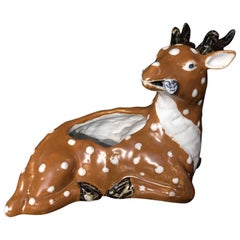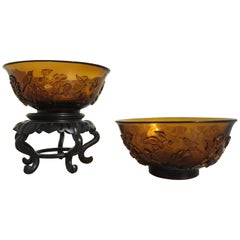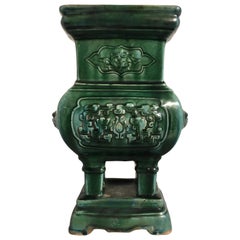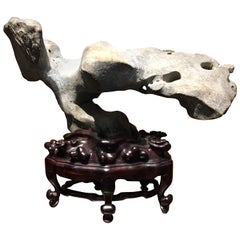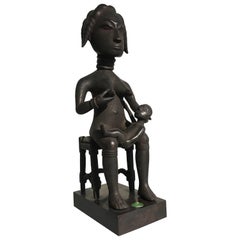Lotus Gallery Furniture
to
2
446
441
4
1
3
3
2
1
1
1
1
147
115
179
5
102
56
17
47
9
11
12
3
2
11
7
3
2
193
143
119
96
78
404
317
183
107
65
446
446
446
2
1
1
1
1
Chinese Qing Dynasty Porcelain Spotted Deer Brush Washer, Mid-19th Century
Located in Austin, TX
A charming and elegant Chinese brush washer in the form of a recumbent spotted deer, Qing dynasty, circa 1850.
The graceful animal modeled with ...
Category
Antique Mid-19th Century Chinese Qing Scholar's Objects
Materials
Porcelain
Pair of Chinese Amber Peking Glass Carved Bowls, Qing Dynasty, Late 19th Century
Located in Austin, TX
A fine pair of late 19th century Chinese Qing dynasty carved Peking glass bowls in a lovely amber hue.
The matching Peking glass bowls carved with opposing scenes of birds amongst flowering branches on a rocky outcrop. The amber glass bowls...
Category
Antique Late 19th Century Chinese Qing Decorative Bowls
Materials
Glass
Large Chinese Late Republic Period Famille Jaune et Rose Porcelain Vase
Located in Austin, TX
A large Chinese famille rose et jaune porcelain vase, with a six character Da Qing Guangxu Nian Zhi mark, but late Republic Period, circa 1940.
Of unusual fo...
Category
Vintage 1940s Chinese Qing Ceramics
Materials
Porcelain
Chinese Qing Dynasty Green Glazed Incense Burner, Late 19th Century
Located in Austin, TX
A charming Chinese green glazed pottery censer or incense burner, Qing Dynasty, late 19th century. Now suitable for use as a jardiniere or vase.
The incense burner in glazed a deep green, in imitation of bronze models, and set on four tapered legs attached to a rectangular stand...
Category
Antique Late 19th Century Chinese Qing Planters, Cachepots and Jardinières
Materials
Pottery
Chinese Gray Lingbi Scholar Stone, Early 20th Century
Located in Austin, TX
A fantastic Chinese scholar's stone, called gongshi, of gray lingbi limestone, mounted on a hardwood stand, late Qing or early Republic, early 20th century, circa 1910, China
.
The ...
Category
Early 20th Century Chinese Qing Scholar's Objects
Materials
Limestone
Ashanti Mother and Child Maternity Figure Carved by Osei Bonsu, Ghana
By Osei Bonsu
Located in Austin, TX
A fine Ashanti maternity figure by the master carver Osei Bonsu. The mother figure is seated on a simple backless chair. An infant lays calmly in her la...
Category
Vintage 1930s Ghanaian Tribal Tribal Art
Materials
Wood
Chinese Carved Zitan Figure of a Bodhisattva, Qing Dynasty
Located in Austin, TX
A finely carved Chinese zitan wood figure of an unidentified bodhisattva, possibly Guanyin, late Qing Dynasty, circa 1900, China.
The androgynous figure has a plump, almost matronly face, with downcast eyes and a gentle smile. The hair in long tresses, gathered and tied in a high chignon.
The enlightened being is portrayed seated in dhyanasana, bare feet resting on crossed legs, both soles pointing up.
Thick robes billow and drape around the full figured body. The hands display...
Category
Early 20th Century Chinese Qing Sculptures and Carvings
Materials
Lapis Lazuli
Japanese Art Nouveau Bronze Lobed Vase with Silver Overlay
Located in Austin, TX
An attractive Japanese Art Nouveau silver overlaid bronze vase, late Meiji period, early 20th century, Japan.
A tall and elegant bronze vase of q...
Category
Vintage 1910s Japanese Art Nouveau Vases
Materials
Silver, Bronze
Japanese Cloisonne Box by Inaba, Meiji Period, circa 1900, Japan
By Inaba Cloisonne Co.
Located in Austin, TX
A fine Japanese cloisonne hinged box with pheasant and autumn foliage, by Inaba Nanaho and the Inaba Cloisonne Company, Meiji period, circa 1900, ...
Category
Antique Early 1900s Japanese Meiji Metalwork
Materials
Copper, Enamel, Metal
Tibetan Leather Painted Trunk
Located in Austin, TX
A charming Tibetan painted leather storage trunk, 18th century, Tibet.
Of smaller size, the softwood construction of the trunk covered by a richly tanned yak leather. The central p...
Category
Antique Late 18th Century Tibetan Tibetan Furniture
Materials
Wrought Iron
Chinese Carved Wood Bodhisattva Guanyin, Late Ming Dynasty, 17th Century
Located in Austin, TX
An attractive carved wood figure of the Bodhisattva Avalokiteshvara, known as Guanyin in China, late Ming Dynasty, early 17th century, China.
Guanyi...
Category
Antique Early 17th Century Chinese Ming Sculptures and Carvings
Materials
Gesso, Wood
Chinese Dian Culture Large Gold Cuff, circa 2nd Century BC, Southern China
Located in Austin, TX
A large and impressive solid high karat gold cuff from the Dian Kingdom, circa 2nd century BC, modern day Yunnan Province, China.
.
This striking cuff is crafted from hand hammered ...
Category
Antique 15th Century and Earlier Chinese Han Antiquities
Materials
Gold
Chinese Craved Hardwood Coffee Table, Early 20th Century, China
Located in Austin, TX
A handsome Chinese carved hardwood coffee table with a design of dragons, Republic Period, early 20th century, circa 1920, China.
The table well-proportioned and well-carved. The top is comprised of a single, solid floating panel. The apron has been carved and pierced with pairs of enchanting and energetic dragons that writhe and weave amongst the clouds, the flaming pearl of wisdom between them. The cabriole leges feature further dragon heads, ending in paw and clawed...
Category
Early 20th Century Chinese Furniture
Materials
Hardwood
Gandharan Column Capital Fragment with an Image of the Buddha
Located in Austin, TX
A bold and expressive Gandharan carved gray schist column capital fragment, circa 2nd - 3rd century, ancient region of Gandhara.
The fragment of a c...
Category
Antique 15th Century and Earlier Pakistani Hellenistic Sculptures
Materials
Schist
Chinese Ming Dynasty Longquan Celadon Peony Deep Dish, 14th-15th Century
Located in Austin, TX
A beautiful Chinese celadon glazed deep dish with an impressed peony design to the center, Ming Dynasty, circa 1400, Longquan kilns, China.
The lovey dish covered in an attractive ...
Category
Antique 15th Century and Earlier Chinese Ming Ceramics
Materials
Porcelain
Ming Dynasty Longquan Celadon Dish with Geometric Design, 15th Century
Located in Austin, TX
A heavily potted and richly glazed celadon dish, Longquan kilns, early Ming Dynasty, mid 15th century, China.
The large dish glazed in a deep olive cela...
Category
Antique 15th Century and Earlier Chinese Ming Ceramics
Materials
Ceramic
Densatil Gilt Bronze Caryatid Figure, Tibet, 15th Century
Located in Austin, TX
A heavy and solidly cast, richly gilt, bronze caryatid figure from Densatil Monastery, Central Tibet, early 15th century or earlier.
Cast in the form of two four armed figures standing back to back in tribhanga (thrice bent position) on a lotus platform, this piece would originally have served as a pillar for a larger seated deity...
Category
Antique 15th Century and Earlier Tibetan Tibetan Sculptures and Carvings
Materials
Bronze
Chinese Archaisit Cast Bronze Ding Tripod Censer, Early 20th Century, China
Located in Austin, TX
A well cast Chinese archaistic bronze tripod censer, ding, in the Ming style, Republic Period, early 20th century, China.
Heavily cast in the arc...
Category
Early 20th Century Chinese Archaistic Metalwork
Materials
Bronze
Pair of Chinese Export Porcelain Court Lady Candle Holders, Mid-20th Century
Located in Austin, TX
A lovely pair of Chinese export porcelain candle holders in the form of court ladies holding lotus blossoms, mid 20th century, circa 1960's, China.
Modeled after 18th century Qianlo...
Category
Mid-20th Century Chinese Qing Sculptures and Carvings
Materials
Porcelain
Pair of Japanese Edo Period Parcel-Gilt Bronze Dragon Vases, Early 19th Century
Located in Austin, TX
A pair of well cast and dramatic Japanese parcel gilt bronze dragon vases, Edo period, early 19th century. The heavy bronze vases of pear shape, each with a single writhing dragon cast in high relief...
Category
Antique Early 19th Century Japanese Edo Metalwork
Materials
Bronze
Japanese Abstract Expressionist Carved Wood Sculpture by Takao Kimura
By Takao Kimura
Located in Austin, TX
A powerful abstract expressionist caved elm wood sculpture by Japanese artist Takao Kimura, circa 1970s. Carved in two parts, the swooping, concave body plays dramatically with the o...
Category
Vintage 1970s Japanese Expressionist Abstract Sculptures
Materials
Elm
Chinese Republic Period Porcelain Figure of Shouxing, the God of Longevity
Located in Austin, TX
A finely modeled Chinese porcelain figure of the Chinese God of Longevity, Shouxing, Republic Period, early 20th century, China.
The God of Longevity, called Shouxing or Shoulao, stands upright holding a dragon staff in one hand, a peach (a symbol of immortality), in the other.
He is dressed in a long yellow robe...
Category
Early 20th Century Chinese Qing Sculptures and Carvings
Materials
Porcelain
Large Late Qing Dynasty Chinese Cast Bronze Buddhistic Foo Lion Censer
Located in Austin, TX
A large and powerfully cast Chinese bronze censer in the form of two Buddhistic lions, Qing dynasty, late 19th century. The censer is well cast with a strong sense of movement, featuring a pair of fierce Buddhistic lions playfully antagonizing each other. Locked in a mock battle, the smaller lion...
Category
Antique Late 19th Century Chinese Qing Sculptures and Carvings
Materials
Bronze
Large Early Tang Dynasty Painted Pottery Model of a Prancing Horse, TL Tested
Located in Austin, TX
A magnificent and large early Tang dynasty (618-906 AD) model of a prancing or dancing horse, circa 7th century.
The majestic animal is caught mid-motion, one leg raised, head grace...
Category
Antique 15th Century and Earlier Chinese Tang Antiquities
Materials
Pottery
12th Century Indian Carved White Marble Figure of a Jain Tirthankara or Jina
Located in Austin, TX
A well carved Indian white marble Jain temple relief fragment featuring an image of a Jina, circa 12th century, Rajasthan or Gujarat, India.
The Tirthan...
Category
Antique 15th Century and Earlier Indian Antiquities
Materials
Marble
Japanese Kutani Porcelain Figure of a Geisha or Bijin, Showa Era, 1930's, Japan
Located in Austin, TX
A lovely Kutani porcelain model of a beautiful woman, bijin, or perhaps a geisha, Showa era, circa 1930's, Japan.
A charming and delightful Japanese Kutani enameled porcelain figure of a bijin or geisha, early Showa Era, circa 1930's, Japan.
The elegant figure of a beautiful woman, called a bijin, or perhaps a geisha, is portrayed dressed in full kimono and holding a closed folding fan in one hand. Her kimono of a rich and deep blue hue, with images of plump pomegranates in gilt. Her wide obi of a striking red color, and patterned with branches of pink blossoms. One foot, clad in a white tabi...
Category
Vintage 1930s Japanese Showa Sculptures and Carvings
Materials
Porcelain
Japanese Kutani Porcelain Figure of a Bijin or Geisha, Showa Era, 1930's, Japan
Located in Austin, TX
A charming and delightful Japanese Kutani enameled porcelain figure of a bijin or geisha, early Showa Era, circa 1930's, Japan.
The elegant figure of a beautiful woman, called a bijin, portrayed dressed in full kimono and holding a fan in one hand. Her kimono of deep black with scattered cherry blossoms in white and outlined in gilding. Her wide obi of coral color, and patterned with stylized clouds of turquoise green and puce. One foot, clad in a white tabi...
Category
Vintage 1930s Japanese Showa Sculptures and Carvings
Materials
Porcelain
Pre-Khmer Pottery Pouring Vessel, Kendi, 6th-8th Century, Cambodia
Located in Austin, TX
An evocative large pottery pouring vessel, kendi, pre-Khmer, 6th-8th century, Cambodia.
The large kendi of typical form, with a bulbous body set on a...
Category
Antique 15th Century and Earlier Cambodian Ceramics
Materials
Pottery
Large Pre-Khmer Pottery Pouring Vessel, Kendi, 6th - 8th Century, Cambodia
Located in Austin, TX
A large and attractive pre-Khmer red pottery kendi, pouring vessel, 6th - 8th century, Cambodia.
The large vessel crafted of a red pottery, with a wid...
Category
Antique 15th Century and Earlier Burmese Ceramics
Materials
Pottery
Chinese Cloisonne Incense Tool Vase, Qing Dynasty, 18th/19th Century, China
Located in Austin, TX
A small and elegant Chinese cloisonné vase for incense tools, Qing Dynasty, 18th/19th century, China.
Made for the scholar's studio, this small refined vase, was used to hold incense tools, including a small pair of tongs or chopsticks and spoon. The tools no longer present.
Of miniature baluster vase form, the vase beautify proportioned and decorated in the cloisonné enamel technique, with gilt wires forming the cloisons, or partitions. Within the cloisons, colorful enamels have been expertly laid.
The small incense tool vase...
Category
Antique Early 1800s Chinese Qing Scholar's Objects
Materials
Copper, Enamel
Chinese Ming Dynasty Bronze Nanhai Guanyin, 16th/17th Century, China
Located in Austin, TX
A decidingly charming Chinese polychromed and gilt cast bronze figure of Nanhai Guanyin, Guanyin of the South Sea, Ming Dynasty, 16th/17th century, China.
Guanyin, the bodhisattva of compassion, is portrayed here as a beatific figure seated upon a raised lotus pedestal over waves. Guanyin is dressed in heavy robes, and wears an elaborate headdress. The small figure of Amitabha Buddha in the headdress positively identifies this figure as Guanyin.
Guanyin rests one hand in his lap, holding a cup of pure water said to be able to alleviate all suffering. His other hand is raised, holding a willow branch which is used to sprinkle the healing waters.
The two lotus blossoms to either side of Guanyin would originally have supported figures of the acolytes...
Category
Antique Early 1600s Chinese Ming Sculptures and Carvings
Materials
Bronze
Large Bronze Dancing Shiva, Nataraja, 19th/20th Century, South India
Located in Austin, TX
A heavy and well cast South Indian bronze figure of Shiva Nataraja, or Shiva as Lord of the Dance, in the Chola style, late 19th or early 20th century, India.
Shiva is portrayed here in his form as Nataraja, the Lord of the Dance. An iconic and powerful image, Shiva is portrayed engaged in his dance of creation, protection, and destruction, bringing together all his aspects into one sublime form.
Shiva dances ecstatically, facing the viewer with his body twisted, his long locks of hair streaming out around him, his four arms in action, with one leg raised, the other stomping on the dwarf demon Apasmara, who represents spiritual ignorance.
In one hand he holds a damaru, or ritual drum...
Category
Antique Early 1900s Indian Sculptures and Carvings
Materials
Bronze
Chinese Cloisonne Incense Burner, circa 1960's, China
Located in Austin, TX
A fine and beautifully enameled Chinese cloisonne incense burner, censer, with pierced cover, mid 20th century, circa 1960's, China.
The ce...
Category
Vintage 1960s Chinese Qing Metalwork
Materials
Copper, Enamel
Small Korean White Glazed Porcelain Moon Jar, Joseon Dynasty, 18th/19th Century
Located in Austin, TX
A subtle and sublime small Korean white glazed porcelain moon jar, Joseon Dynasty, 18th/19th century, Korea.
The small moon jar of typical form, ...
Category
Antique Early 1800s Ceramics
Materials
Porcelain
Chinese Neolithic Qijia Culture Red Pottery Vessel, 2200 BC - 1600 BC, China
Located in Austin, TX
An attractive Neolithic Chinese burnished red pottery vessel, Qijia Culture (2200 BC - 1600 BC), modern day Gansu Province, China.
The vessel of compressed globular form set on a short, pieced pedestal foot, and featuring two ear handles, a short, wide neck, and slightly everted mouth. A simple incised band decorates the otherwise plain body.
The red pottery with a beautiful rich terracotta hue. The slight burnishing makes the vessel glow.
The Qijia Culture was a late Neolithic...
Category
Antique 15th Century and Earlier Chinese Ceramics
Materials
Pottery
Korean Silla Dynasty Footed Jar, circa 6th Century, Korea
Located in Austin, TX
A charming Korean high fired gray pottery stoneware footed vessel, Three Kingdoms Period, Silla Kingdom, circa 6th century.
The vessel of traditiona...
Category
Antique 15th Century and Earlier Korean Antiquities
Materials
Pottery, Stoneware
Chinese Neolithic Qijia Culture Red Pottery Vessel, 2200 BC - 1600 BC, China
Located in Austin, TX
A sublime Chinese neolithic burnished red pottery jug, Qijia Culture (2200 BC - 1600 BC), modern day Gansu Province, China.
The simple jug of alluring form, with a voluptuous body, short, narrow neck with slightly everted mouth, and a single ear handle.
The red pottery of gorgeous shades of terracotta, and slightly burnished.
Overall surprisingly contemporary for a piece over three thousand years old.
The Qijia Culture was a late Neolithic...
Category
Antique 15th Century and Earlier Chinese Ceramics
Materials
Pottery
Chinese Spinach Green Jade Incense Tool Vase, Qing Dynasty, 18th/19th Century
Located in Austin, TX
A fine and well carved Chinese spinach jade incense tool vase, Qing Dynasty, Qianlong or Jiaqing Period, 18th/19th century, China.
The small jade vase ...
Category
Antique Early 19th Century Chinese Qing Scholar's Objects
Materials
Jade
Chinese Archaic Bronze Wine Vessel, Bianhu, Han Dynasty, China
Located in Austin, TX
A sublime Chinese archaic bronze wine vessel, called a bianhu, Han Dynasty (206 BC - 220 AD), China.
The bianhu with a flattened oblong body,...
Category
Antique 15th Century and Earlier Chinese Han Antiquities
Materials
Bronze
Japanese White Glazed Hirado Ware Puppy, Edo/Meiji Period, Mid 19th Century
By Hirado
Located in Austin, TX
An absolutely adorable Japanese Hirado Mikawachi ware white glazed porcelain model of a puppy dog, Edo to Meiji period, early to mid 19th century, Japan.
The cute puppy is portray...
Category
Antique Mid-19th Century Japanese Meiji Sculptures and Carvings
Materials
Porcelain
Japanese Kutani Pheasant Sculpture, Okimono, Showa Era, Early 20th Century
Located in Austin, TX
A spectacularly glazed Japanese Kutani model, okimono, of a pheasant, Showa era, early 20th century, Japan.
The okimono, or decorative sculpture, in the form of a magnificent phea...
Category
Vintage 1930s Japanese Showa Ceramics
Materials
Porcelain
Japanese Aote Kutani Phoenix Censer, Koro, Showa Era, Japan
Located in Austin, TX
A fantastic Japanese Aote type Kutani incense burner, koro, in the form a phoenix, Showa era, circa 1930's, Japan.
The censer, koro, gracefull...
Category
Vintage 1930s Japanese Showa Ceramics
Materials
Porcelain
Chinese Siwa Culture Burnished Pottery Jar, 1500 - 1100 BC, China
Located in Austin, TX
A striking Chinese Neolithic to Bronze Age burnished red pottery double handled saddle mouth storage jar, Siwa Culture (circa 1500 to 1100 BC), modern day Gansu Province, China.
...
Category
Antique 15th Century and Earlier Chinese Ceramics
Materials
Pottery
Japanese Bronze Okimono of a Carp, Taisho Period, Early 20th Century, Japan
Located in Austin, TX
An elegant Japanese cast bronze okimono of a swimming carp, Taisho Period (1912 - 1926), early 20th century, Japan.
The graceful fish portrayed realistically in motion, as if swimmi...
Category
Vintage 1920s Japanese Taisho Sculptures and Carvings
Materials
Bronze
Pair Japanese Carved and Lacquered Inari Foxes, Showa Era, Dated 1951, Japan
Located in Austin, TX
A delightful and mischievous pair of Japanese carved and lacquered wood Inari foxes, kitsune, dated Showa year twenty six, corresponding to 1951, Japan.
The...
Category
Vintage 1950s Japanese Showa Sculptures and Carvings
Materials
Elm
Pair Japanese Kutani Okimono of Mandarin Ducks, Showa Era, Early 20th Century
Located in Austin, TX
A charming and delightful pair of Kutani glazed porcelain models, okimono, of Mandarin ducks, oshidori, Showa Era, circa 1930's, Japan.
The two Mandarin ducks, called oshidori in ...
Category
Vintage 1930s Japanese Showa Ceramics
Materials
Porcelain
Large Korean Iron Red Glazed Bamboo and Plum Vase, 20th Century, Korea
Located in Austin, TX
A large and boldly painted Korean "Bamboo and Plum" underglaze iron brown porcelain vase, 20th century, Korea.
The large porcelain vase of baluster vase form with generous proportions. The bulbous body with high, wide shoulders, tapering down to a flat recessed foot. The body decorated in underglaze iron brown with large designs of tall, leafy bamboo stalks to one side. The opposite side with gnarled branches of blossoming plum.
Bamboo is revered in Korea, and Asia in general for its strength, flexibility and quick growing nature. Plum is invested with similar ideals, representing strength and resilience, as it flowers in the depth of winter.
The neck and shoulders featuring a design of stylized clouds. The base with a band of stylized waves. All in underglaze iron brown.
The vase with a transparent overglaze of bluish white.
The vase modeled after a 16th century Joseon vase...
Category
20th Century Korean Ceramics
Materials
Porcelain
Chinese Famille Verte Porcelain He-He Er Xian Group, Early 20th Century, China
Located in Austin, TX
A delightful famille verte enameled porcelain figural group of the He-He Er Xian, the Twins of Harmony and Union, late Qing Dynasty, circa 1900, China.
The He-He Er Xian are portr...
Category
Early 20th Century Chinese Qing Ceramics
Materials
Porcelain
Gandharan Terracotta Figure of the Bodhisattva Maitreya, 4th-6th Century
Located in Austin, TX
A very rare and decidedly charming half-scale terracotta sculpture of the bodhisattva Maitreya, the Buddha of the Future, ancient region of Gandha...
Category
Antique 15th Century and Earlier Pakistani Sculptures and Carvings
Materials
Terracotta
Large Chinese Carved and Lacquered Buddha, Qing Dynasty, 19th Century
Located in Austin, TX
A large and magnificent near life-sized Chinese carved and lacquered wood figure of a Buddha, Qing Dynasty, 19th century or earlier, southern China.
The figure likely represents one of the Five Tathagatas, also known as Dhyani Buddhas or Wisdom Buddhas. More specifically, either Amitabha or Amoghasiddhi. Amitabha is the Buddha of infinite light, and represents the wisdom of observation and recognition. Amoghasiddhi is the Buddha of accomplishment, and represents the wisdom of perfected practices. The size and scale of the Buddha indicates it was made for temple worship.
The large Buddha is portrayed seated in vajrasana, or full lotus position, with the soles of both feet facing up. His elegant hands, with impossibly long and slender fingers, perform shuni mudra, the gesture of bestowing patience. His right arm is bent at the elbow, the right hand raised to heart level. The left arm resting gently in his lap, the left hand at navel level.
The Buddha is dressed in voluminous robes that wrap around his shoulders and body, and tied at the waist. The heavy fabric draping and pooling elegantly all around his robust body. His broad chest and right arm exposed.
The Buddha's face is both solemn and beatific - his expression seeming to change depending on the angle of view. The most notable feature of his face is the large urna to the center of his forehead, set between a pair of painted, high arching brows over heavily lidded almond shaped eyes. A strong nose is set above a small mouth pursed in an ever so slight smile. Long pendulous earlobes touch his shoulders.
The Buddha's hair arranged in the typical fashion, with "spikes" representing tight curls. A prominent ushnisha rises from the crown of his head, covered by more hair, and topped with a rounded protuberance.
The Buddha is constructed from several blocks of wood, joined, carved and lacquered a deep red-brown with gold flecks...
Category
Antique 19th Century Chinese Qing Sculptures and Carvings
Materials
Wood
Japanese Kutani Treasure Boat 'Takarabune' Censer, Taisho Period, Japan
Located in Austin, TX
A wonderful Japanese Kutani porcelain incense burner, koro, in the form of a treasure ship, Takarabune, Taisho Period (1912 - 1926), Japan.
The censer boldly modeled as the legendary Takarabune, or Treasure Ship, a mythical ship said to carry the shichifukujin, the Seven Lucky Gods, around the heavens during the first days of the New Year, visiting lucky humans to bring blessings and prosperity.
The black bodied, single mast ship sails on the water, its sail full of wind and decorated with the character "takara", meaning treasure. The pierced top of the ship serving as the cover for the censer. It is loaded with magical items and treasure, most prominently, a large coral branch...
Category
Vintage 1910s Ceramics
Materials
Porcelain
Chinese Peranakan Inlaid Hardwood Pagoda Display Cabinet, Early 20th Century
Located in Austin, TX
An impressive pagoda form carved hardwood display cabinet with bone and boxwood inlay, crafted for the Peranakan (Straits-Chinese) community in Southeast Asia, mostly likely Malaysia, Indonesia, or Singapore, early 20th century.
The large display cabinet with four wide open shelves for display, set on four clawed feet, and surmounted by a peaked roof topped by a tiered pagoda with carved figures to the interior. A further set of pagodas with figures adorns each corner.
The peaked roof decorated with a pair of magnificent phoenixes in flight flanking a large peony spray and a roundel featuring the goddess Magu and an attendant. The decoration of carved and inlaid boxwood. Clouds of carved bone scattered throughout. The sides of the roof each with a pair of sinuous dragons among clouds, a "shou" (longevity) medallion between them, all of carved and inlaid boxwood.
The sides of the cabinet decorated with images of carved and inlaid boxwood birds and flowers - the left side with peony, the right side with chrysanthemum.
The roof with a carved and pierced gallery below featuring auspicious animals and fruit...
Category
Vintage 1910s Asian Chinoiserie Furniture
Materials
Bone, Hardwood, Boxwood
Japanese Lacquer Sake Cups, Set of 3, Meiji Period, Early 20th Century, Japan
Located in Austin, TX
A finely decorated set of 3 red lacquer sake cups, sakazuki, featuring views of Mt. Fuji, Meiji period, circa 1900, Japan.
The lacquer sake cups, called sakazuki, of traditional p...
Category
Antique Early 1900s Japanese Meiji Lacquer
Materials
Lacquer
Japanese Satsuma Incense Burner, Koro, Meiji Period, Late 19th Century, Japan
Located in Austin, TX
A fine and elegant Japanese Satsuma tripod incense burner, koro, with pierced metal lid, signed Eizan (?) Meiji Period, late 19th century, Japan.
The koro, or censer, features a stoneware body of slightly compressed globular form, supported on three short and squat legs. The wide mouth with a recessed metal rim, and topped by an openwork metal lid topped with overlapping chrysanthemum blossoms of silver repousse.
The body of the koro finely painted with fan shaped cartouches. The fans in the foreground with sprays of blossoming chrysanthemum. The fans in the background with intricate geometric brocade designs.
The shoulder of the incense burner decorated with cartouches formed as stylized chrysanthemum petals, and intricately decorated with geometric and floral brocade designs.
The painting finely done in raised gilt and polychrome enamels, including the highly desirable gosu blue...
Category
Antique Late 19th Century Japanese Meiji Ceramics
Materials
Silver, Metal
Japanese Parcel Gilt Copper Hibachi, Edo Period, 18th Century, Japan
Located in Austin, TX
A sublime Japanese parcel gilt copper hand warmer, hibachi, with chrysanthemum design, Edo Period, 18th century, Japan.
The hand warmer, called a...
Category
Antique 18th Century Japanese Edo Metalwork
Materials
Copper
Large Japanese Satsuma Covered Vase, Showa Period, Mid 20th Century, Japan
Located in Austin, TX
A very large and exuberantly decorated Japanese Satsuma millefleur covered vase, marked Satsuma, Showa period, mid 20th century, Japan.
The large vase of attractive baluster form, with a slightly splayed foot, narrow waist, and tapered body with high shoulders and short neck. The vase topped by a domed cover with a large finial shaped like a hoju, the wish fulfilling jewel.
The vase decorated all over in a dense field of flowering blossoms - peony, lotus, and chrysanthemum - in a design known as millefleur, or a thousand flowers. The flowers freely and cheerfully painted in various colors of red, white, orange, green, blue and yellow, with raised white enamels...
Category
Mid-20th Century Japanese Showa Ceramics
Materials
Stoneware
Large Chinese Porcelain Five Dragon Meiping Vase, Modern, China
Located in Austin, TX
A large and powerful Chinese famille rose enameled porcelain "Five Dragon" meiping vase, modern, China.
The oversized vase of traditional meiping form, with a splayed foot supporting a baluster shaped body with high shoulders, short, narrow neck, and rolled mouth rim.
The large vase decorated with five dragons molded in relief. Their bodies painted in vibrant overglaze famille rose enamels of reds, greens, yellows and turquoise.
The dragons portrayed dancing in the sky among flames and clouds. Their bodies twisting and writhing, claws extended, tails coiled, some with mouths open in triumphant roars. The main dragon in red, and portrayed to more directly face the viewer.
The dragons dance against a white ground sky. The blank sky broken up by overglaze red painted stylized clouds and flames. The foot decorated with a band of crashing waves. A stylized lotus blossom surrounds the base of the neck. The neck with a band of scrolling flowers and vines against a yellow ground.
The underside of the large vase with an apocryphal "Da Qing Qianlong Nian Zhi...
Category
Early 2000s Chinese Qing Ceramics
Materials
Porcelain
Japanese Art Nouveau Cloisonne and Ginbari Amphora Vase, Meiji Period, Japan
Located in Austin, TX
An unusual and elegant Japanese Art Nouveau amphora shaped cloisonne and ginbari foiled vase, Meiji Period, circa 1900, Japan.
The vase of amphora form, with a tapering body resti...
Category
Antique Early 1900s Japanese Art Nouveau Metalwork
Materials
Copper, Enamel, Foil, Wire
Two Small Japanese Cloisonne Dragon Vases, Early 20th Century, Japan
Located in Austin, TX
Two charming, small Japanese cloisonné dragon vases, Meiji to Taisho period, early 20th century, Japan.
The miniature vases of baluster f...
Category
Early 20th Century Japanese Taisho Metalwork
Materials
Copper, Enamel, Foil
Group of 5 Small Japanese Cloisonne and Ginbari Vases, Early 20th Century, Japan
Located in Austin, TX
A charming group of five Japanese cloisonné and ginbari foiled vases, Meiji period, early 20th century, Japan.
The group consists of one vase with cloisonné chrysanthemum blossoms against bold and bright turquoise ginbari foil background, two similar vases of primarily black and burgundy cloisonné - one with a butterfly motif, the other with a floral motif, and two similar vases of primarily dark blue and green cloisonné, both with floral and butterfly motifs.
Turquoise ginbari vase...
Category
Early 20th Century Japanese Meiji Metalwork
Materials
Copper, Enamel, Foil, Wire
